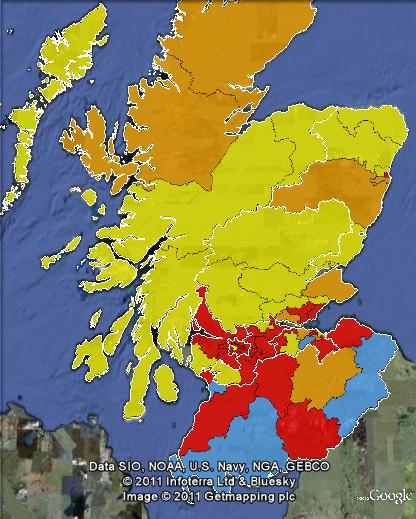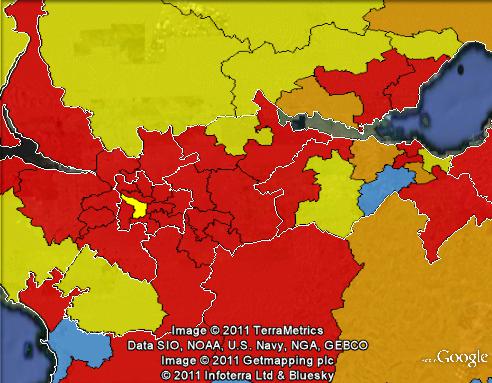Alongside elections to the National Assembly of Wales and the Northern Ireland Assembly, voters in Scotland will be voting in the fourth election for the Scottish Parliament.
The Scottish Parliament was set up in 1999 following a referendum in 1997 which decisively voted in favour of setting up a national Parliament, with over 74% of voters voting yes. The new Labour government of Tony Blair had picked up the issue as unfinished business from the last Labour government.
The last Labour government had proposed a devolution referendum in 1979, which was narrowly defeated before the Conservatives took power at Westminster later that year.
The Conservative government became particularly unpopular in Scotland in the 1990s, and in 1997 were wiped out in Scotland, winning none of Scotland’s 72 seats.
The Scottish Parliament is elected using the Additional Member System, similar to that used in New Zealand and Germany, and also used to elect the National Assembly of Wales and the Greater London Assembly.
The Scottish Parliament includes 73 members elected by single-member constituencies. In addition, another 56 members are elected in regional lists for eight regions across Scotland. This proportional system has produced three consecutive hung parliaments.
Originally, the Scottish Parliament used the same boundaries for 71 of their constituencies as were used for the House of Commons. The Westminster constituency of Orkney and Shetland was divided into two constituencies for the Scottish Parliament.
Prior to the creation of the Scottish Parliament, Scotland was overly represented in the House of Commons. Following the creation of the Parliament, new boundaries were drawn for the 2005 UK general election, cutting Scotland’s seats at Westminster to 59.
The original boundaries were used for the 1999, 2003 and 2007 elections. The Scottish Parliament will be using newly-drawn boundaries for the 2011 elections. Both of these maps can be downloaded from my maps page.
At the first election in 1999, Labour won a vast majority of single-member districts, but the top-up seats meant that Labour won 56 seats overall, 9 seats short of a majority. The largest beneficiary of the proportional system was the Scottish National Party, who won 7 constituencies and a further 28 top-up seats. The Conservatives managed to win 18 top-up seats after winning no constituencies.
The Labour Party, led by Donald Dewar, formed a coalition government with the Liberal Democrats. Dewar served as First Minister until his death in 2000, when he was succeeded by Henry McLeish. He served until he resigned due to a scandal in 2001. The Labour-Liberal Democrat coalition was then led by Jack McConnell.
The opposition in the first Scottish Parliament was led by the Scottish National Party. The SNP had long been a minor party winning a small number of seats in the House of Commons, leading the campaign for Scottish independence, but in the new Parliament became a major party, due to the weakness of the Conservatives in Scotland.
The SNP has largely taken left-wing stances on other issues alongside their stance in favour of more devolution to the Scottish Parliament and eventual independence for Scotland.
Alex Salmond led the Scottish National Party from 1990 to 2000, serving as the first Opposition Leader in the Scottish Parliament. He resigned as SNP leader in 2000 and focused on his seat in the House of Commons. In 2004, he was again re-elected as SNP leader, but held the position while only holding a seat in the House of Commons, not the Scottish Parliament.
At the 2003 election, both Labour and the SNP lost seats, largely to smaller parties. The Scottish Green Party and the Scottish Socialist Party each won a single seat in 1999. In 2003, the Greens increased their representation to 7 seats, and the Socialists won 6. Following the election the Labour-Lib Dem coalition continued in government, but with a much smaller majority.
At the 2007 Scottish election, SNP leader Alex Salmond announced his intention to run for the Lib Dem-held seat of Gordon, neighbouring his former seat of Banff and Buchan.
A swing of 10% to the SNP saw them win the largest number of seats. The SNP gained twelve constituencies, but the Labour Party still won a majority of single-member seats. Labour lost four seats overall, while the SNP gained twenty seats. The Conservatives and Liberal Democrats each lost a single seat, while five of the seven Greens were defeated, and all six Socialists were defeated.
The overall seat figures were:
- SNP – 47 (21 constituency, 26 list)
- Labour -46 (37 constituency, 9 list)
- Conservative -17 (4 constituency, 13 list)
- Liberal Democrats – 16 (11 constituency, 5 list)
- Greens – 2 list seats
- Independent Margo MacDonald – 1 list seat


Following the election, the Scottish National Party formed a minority government, which has been in power for the last four years.
In recent polls, both Labour and the SNP are projected to improve on their position. While the Conservative vote remains fairly steady since 2007, the Lib Dems appear on track to lose many of their seats.
With the Lib Dems losing ground, the prospect has arisen that one of the major parties could gain a majority in the Parliament, although it still remains difficult under the Scottish electoral system.



You are aware that this election will be fought on a new set of boundaries. Professor Denver of Lancaster University has created a PDF with his notional calculations. He reckons that if the new constituencies had been around in 2007, the new starting point would have been: SNP 46 Lab 45 Con 19 Lib Dem 17 Green 1 IndSNP 1
Scottish Labour seems Old Labour but in the rightwing sense they are currently banging on about Tory cuts and accusing SNP of being soft on crime. There is a possibility Greens could hold BOP.
I am aware of the new boundaries, Harry, indeed I spent much of the last three weeks making a new map on those boundaries, and I mentioned it in the above post.
scottish nationalist take full control of the Scottish parliament.surging into LABOUR HEARTLANDS OF Glasgow,the results are staggering.now they have the mandate for referendum on independence.
Comments are closed.